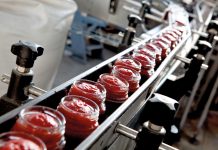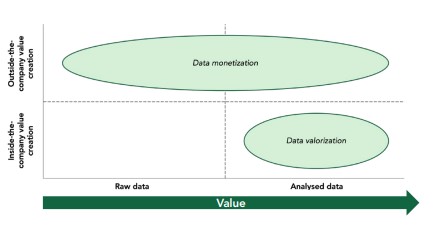
The high price of energy raw materials makes investments in energy efficiency more cost-effective with the same achievable energy savings. A case study in the food sector.
In 2021, an important signal came from the energy efficiency market, which recorded +8% growth in investments in industrial energy efficiency. This positive trend was confirmed by the Digital Energy Efficiency Report 2022, which is released annually by the Energy Strategy Group of the Politecnico di Milano. This enormous work stems from the exchange between sector’s operators and from surveys conducted on the efficiency market.
As expected, it results that the market has been driven both by the sharp increases in energy commodity prices and by the ever-increasing importance of sustainability issues in business activities. The many issues addressed in this report demonstrate, perhaps as a result of this, the willingness of industry operators to take a firm step towards energy efficiency in the industrial sector.
Moreover, the price of electricity is influencing the valuation of industrial energy efficiency investments, making them more cost-effective than in the past with the same achievable energy savings. The case study presented here below certainly is of great interest to the food industry and Food industry operators.
Data valorization and data monetization
Some basic concepts have their validity confirmed. The concepts of data valorization and data monetization refer to how the data collected by digital technologies are exploited. Let’s mention them. “Data valorization” means the use and analysis (carried out internally or by external partners) of the energy data collected by the company’s software platforms, in order to make useful decisions to its own business.
The data can thus support decision-making within the company. “Data monetization” means the sale of energy data collected from digital solutions used by the company, in raw or reprocessed format, in order to obtain a revenue stream (income stream). It can be expressed in graph form, reporting and comparing the degree of processing of the data collected by the company’s sensor systems (sensors, meters, etc.) with an indication of where the data are used and where they create value, whether internally or externally (Figure 1).
It is a fact that companies are often equipped with a variety of systems for measuring energy consumption, but there is also a frequent lack of adequate awareness of the potential value that could be drawn from their analysis. This criticality is also reflected in the company’s limited ability to carry out a critical analysis of the large amount of data available, resulting in a low added value of monitoring activities.
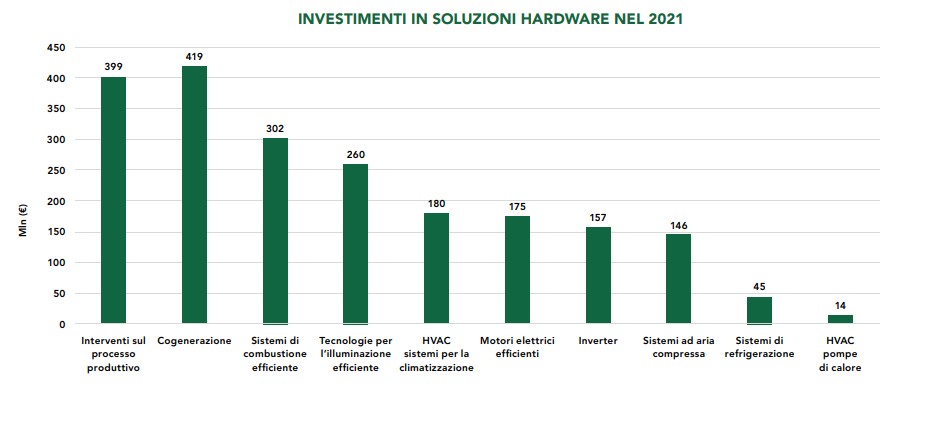
It is “software providers” or “ESCo” who, in addition to offering software solutions capable of analysing the energy data collected on the ground in a structured way, support the customer in interpreting them. In this regard, in the industrial sector, the analysis of the Energy Strategy Group showed how energy data are being used by companies to improve their processes (96% of cases) and optimize their plants (78% of cases), even though more and more companies are trying to identify opportunities to reduce CO2 emissions, through field data analysis. (Figure 2)
Volatility of commodity prices
As evidenced by the numerous feedbacks from market operators gathered in the course of the research, the market for energy-efficiency solutions is significantly affected by the recent volatility of commodity prices. For investment valuations, therefore, the Report considers two forecast scenarios relating to the price of commodities for an industrial consumer.
There are two scenarios: the “Mitigated” scenario considers a 20% reduction compared to the “Worst Case” scenario, where commodity prices remain higher. Figures 3 and 4 show the forecasts in the two scenarios for the electric energy component for an industrial consumer. The components of the energy bill relating to excise duties and taxes are also considered in the analysis of the suitability of investments, which will be discussed later on.
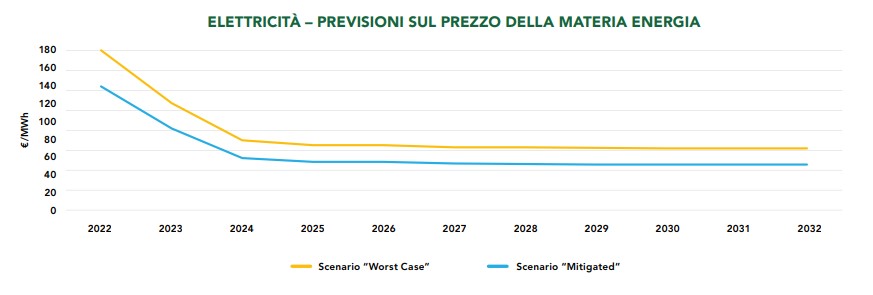
Food industry case
To give substance to the date, the report of the Politecnico has studied the impact of energy efficiency solutions in specific sectors, including the food sector. For this purpose, a large plant with an area of 3,000 m2 was considered, with an electricity requirement of over 32 GWh/year and a heat requirement of 43,5 GWh/year.
For the purposes of analysing the installation of a cogeneration system, a situation where the heat requirement is met by a gas-fired power plant was considered for comparison. As far as lighting is concerned, upstream of the efficiency measure, the application of LED devices for the 300 lamps in the plant was considered.For the valuation method used, a WACC (Weighted Average Cost of Capital) discount rate was considered, which considers 40% equity and 60% debt financing of the investment.

Cogeneration
For this solution, typical in the food sector, the installation of a cogeneration plant alongside an existing “back-up” thermal power plant (Figure 5) was planned. The technical and economic characteristics of the cogenerator are based on the energy profile of the food plant under study, which results in a nominal electric power of 3,000 kWe and an investment of 3,000,000 € (CAPEX) and operating costs (OPEX) of 60,000 €/year.
Energy production (transformation with a total efficiency of 88% into energy goods from primary energy in the form of natural gas) consists of electricity produced at 19,474,860 kWh/year and heat produced at 19,162,600 kWh/year. All this by running the cogenerator for a total of 7,177 operating hours per year. The results of the analysis of this investment in cogeneration in a food processing plant, in the “Worst case” commodity forecast scenario seen above, make the energy savings from cogeneration extremely important from an economic point of view.

In fact, the economic exploitation of electricity savings more than compensates proportionately for the increase in expenditure on natural gas required for the operation of the cogenerator. Therefore, the “Payback Time” of the investment in cogeneration, under the above assumptions, turns out to be 1.8 years, to be compared with a return of around 3 years in pre-energy crisis conditions. The ESG study goes further, proposing the results with, and without, the presence of the White Certificates (CB) incentive mechanism for cogeneration: This is because research has shown that companies very often do not consider this tool in their business plans, due to the uncertainties associated with obtaining it.
Well, rating with CB reduces payback time from 1.8 to 1.5 years, not bad. The same analysis, but carried out in the “Mitigated” scenario, leads to higher payback times, which are closer to the more typical return times of a cogeneration plant if White Certificates are not considered in the business plan. On the other hand, it is clear that the presence of the White certificates mechanism at below “worst case” commodity prices can lead to a significant increase in the return on investment. From the point of view of CO2 emissions at the food plant concerned, the combined generation of heat and power leads to a reduction in emissions of 3,320 t CO2/year.
By looking solely at emissions from gas consumption, however, CO2 levels show an increase compared to the pre-intervention situation, which is understandable given the increased need for natural gas input to the cogeneration system compared to the power station. On the other hand, electricity generation from CHP generates significant CO2 savings (-58%) associated with the emission factor of the domestic thermoelectric generation, which CHP replaces.
Lighting system
The lighting system is one of the most common elements on which to intervene for improving the efficiency of food processing facilities (Figure 6). An efficiency intervention by installing a “smart” LED system typically showed, under pre-energy crisis conditions, a return on investment of about 6 years. The installation of a smart LED lighting system includes, in addition to efficient LED lighting fixtures, an advanced control system based on presence and brightness sensors and the adoption of wireless communication protocols (e. g. Bluetooth) for lighting control.
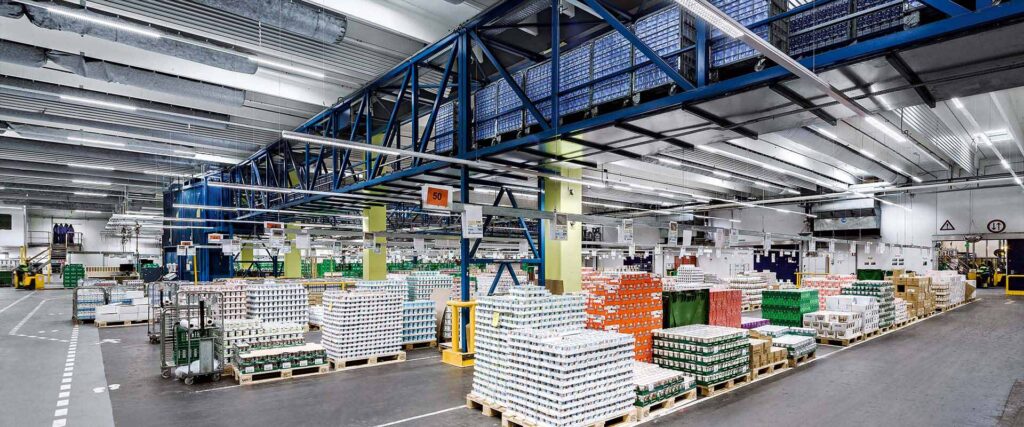
The technical and economic characteristics of the smart LED lighting system considered to replace fluorescence lamps can be summarized in 150 efficient LED fixtures, including devices, for 4,000 operating hours per year, CAPEX 78,400 €, OPEX 390 €/year. Energy savings of 80%. In the “worst case” scenario, the installation of a smart LED lighting system has a return time of 4.2 years.
Considering the “Mitigated scenario” of forecasting electricity prices, which considers a 20% decrease in energy prices compared to the “Worst Case” scenario, there is a rise in the payback time of investment in a smart LED lighting system. This value, equal to 5.2 years, although it is closer to the 6 years return time mentioned earlier, in a situation of pre-energy crisis prices, is still significantly lower. Therefore, despite the difficulties of predicting energy price developments in the coming years, it can be argued that a price development such as that in the “Mitigated scenario” would continue to ensure a high return on investment in lighting for a food industry.
Conclusions
Energy efficiency is increasingly seen as one of the most effective ways of countering today’s sharp increase in energy raw materials. It is effective because it allows a reduction in industrial costs within a reasonably short period of time, of which energy is a major component. This is demonstrated by the return on investment in the face of pre-energy crisis conditions.
The validity of technological solutions is fully established and is also a guarantee against possible (hopefully not) future crises, considering the possible causes of sudden and severe increases in energy supply. Until domestic renewable energy infrastructure can alleviate dependence on foreign energy supplies, efficiency is the best response available to today’s food industry.



